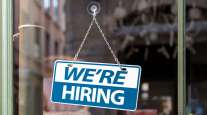Trucking Adds 2,600 Jobs in December
This story appears in the Jan. 17 print edition of Transport Topics.
Trucking added 2,600 jobs in December, helping to reduce the nation’s unemployment rate from 9.8% to 9.4%, the lowest since July 2009, the U.S. Labor Department said in its latest report.
The new hires brought the trucking workforce on a seasonally adjusted basis to 1,250,100, up from a revised 1,247,500 in November, the Bureau of Labor Statistics reported Jan. 7.
December was the third consecutive month that the trucking workforce grew, and industry employment “fits fairly close to what volumes have done — moderate increases,” said American Trucking Associations Chief Economist Bob Costello.
In October trucking added 1,800 jobs, while in November the number of new jobs was 3,600.
“The truck transportation sector made a significant improvement,” said Chris Christopher, senior principal economist for IHS Global Insight.
Trucking’s job numbers are not “the biggest in the world or ever seen but, compared to many other sectors, it’s looking okay,” Christopher said.
The construction industry, for example, lost an additional 16,000 jobs in December, the Labor Department said.
In the trucking industry, despite the recent boost in hiring, the total workforce was still about 200,000 below the January 2007 peak of 1.45 million.
And when new jobs in warehousing are added to those in trucking, the combined hiring total for December was only 8,800 compared with the combined figure of about 20,000 in November.
The outlook for trucking is good, however, because hiring growth in the industry is being driven by increased manufacturing and by an increase in imports, Global Insight’s Christopher said.
“Imports are very important to trucking and that is being driven for the most part by personal consumption expenditures. They’re looking very good,” he said.
Warehouses are restocking to supply retailers, Christopher said, and manufacturing added 10,000 new jobs in December, the Labor Department reported.
Despite the drop in the nation’s unemployment rate, however, hiring overall was less than expected, with the economy creating only 103,000 new jobs last month, a number Costello and other economists said was as puzzling as it was dispiriting.
“The economy is adding workers but there are no reliable signs the pace of hiring is improving,” Julia Coronado, chief economist for North America at BNP Paribas, the global banking and financial services firm, told Bloomberg News.
“We are staying on track but I’m not sure growth is set to accelerate,” she said.
“There’s no way to really sugar-coat this one,” Costello said. “This is disappointing.”
Costello said he and other economists are poring over layers of numbers in an effort to determine why hiring was not as strong as anticipated.
ADP Employer Services, for instance, said four days before the government unveiled its December employment report that companies had raised employment by 297,000 workers.
At the same time, economists polled for a Bloomberg News survey estimated in the days leading up to the jobs report that new hires for December could top 200,000 — the number most economists say is needed each month going forward in order to push the unemployment rate down to pre-recession levels.
“Actually, the opposite happened of what we thought would happen,” said Costello. “We thought more jobs would be created but that the unemployment rate would not fall that much. In fact, fewer jobs were created and the unemployment rate fell more than we thought.”
December was the second disappointing month for job watchers nationwide. In November, only 71,000 jobs were created, according to the government’s revised numbers.
Hopes had been high for a better number after October hiring reached 172,000.
There are still “big negatives hanging out there” that weigh heavily on economic recovery and hiring, Christopher said. He cited the recent escalation in fuel prices, the depressed housing and commercial real estate markets and layoffs in local and state governments as federal stimulus money dries up.
On the positive side for an economy heavily dependent on consumer spending, which increases freight traffic, people are paying off credit cards and there have been charge offs, Christopher said. Once out of debt, consumers are expected to begin spending again, he added.
“The non-mortgage debt to disposable income ratio is at 10-year lows, meaning people are de-leveraging,” he said.
Global Insight predicted that when the figures are in for 2010, personal spending adjusted for inflation will show 1.8% growth over the 2009 decline of 1.2%.
The momentum over the last two quarters of 2010, the firm said in a recent forecast, is expected to spill over into 2011 and produce 3.2% growth in personal spending this year over last year.



